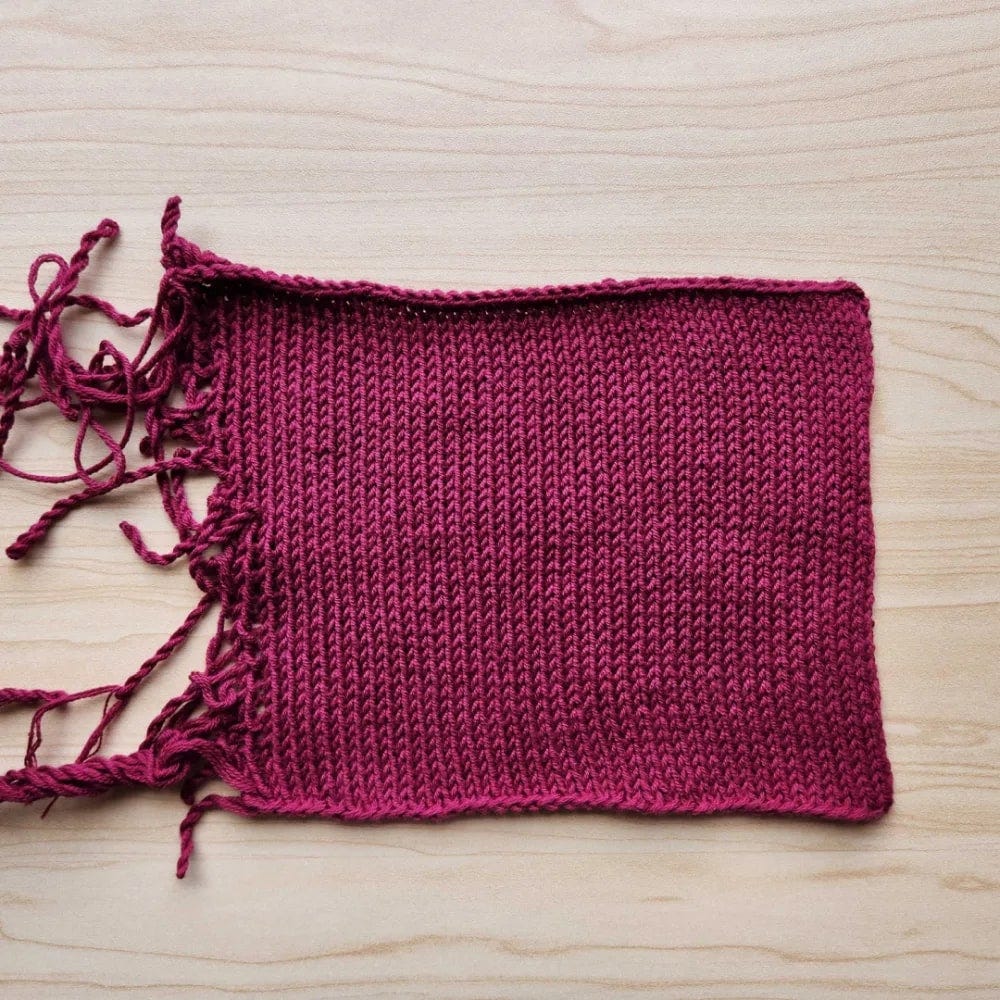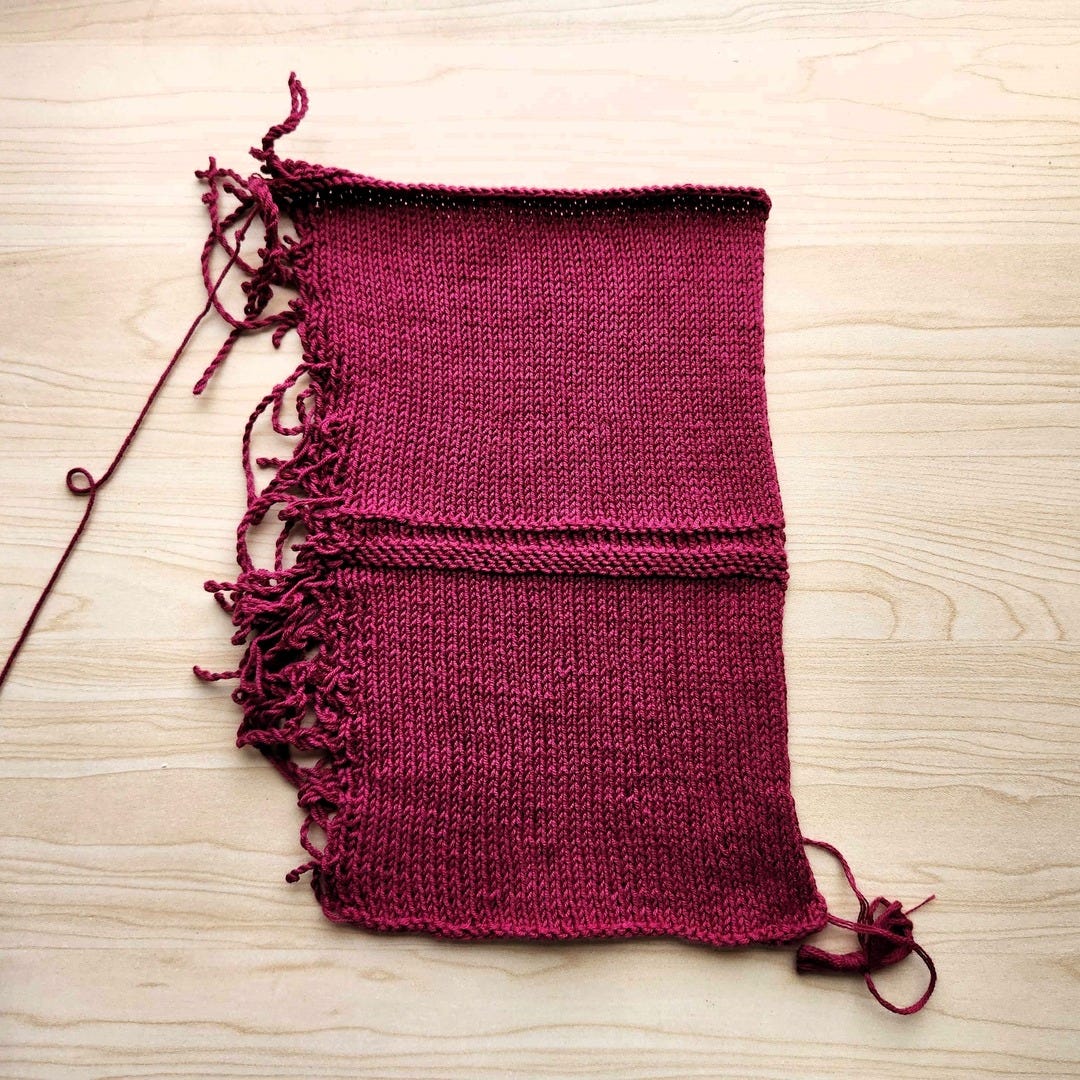I thought I’d swatch for my next project, Flow by Trin Annelie, using Alba organic cotton yarn.
What I’m doing is using the method for swatching I found by Laura Nelkin, where you have the shorter floats at one end.
With this cotton, I could do that successfully. When I tried that method with the bamboo cotton yarn, it was too fiddly.
I’ve completed the gauge swatch and read the pattern. The amount of rows within the gauge swatch is important because that affects how deep your yoke will be. I’m blocking it, and it looks like I don’t have enough rows.
In the gauge, I’m up to 35 and the pattern requires 38 rows for the 4x4 inch swatch. My stitches are fine, but the row gauge isn’t.
So I’ll have to work that out.
I'm yet to try another swatch for my other project that uses the Alba organic cotton yarn where I need to get more rows per inch.
Something I've learned this week is I'm potentially adding more twist to the yarn by knitting the English style and wrapping my yarn counterclockwise.
What I've noticed in that swatch is the loops at the end have twisted up on each other. The fabric I've created looks like corduroy!
I learned from Julia Farewell Clay in one of her videos about whether you wrap your yarn clockwise or counterclockwise matters when you knit.
The corduroy effect is created when the one leg of your stitch is dominant.
That's been fascinating!
I'm going to knit a second swatch using the English style method, but wrap my yarn clockwise. Then I'll see how that affects the fabric.
I'm also going to try another swatch using the Continental method and again, wrapping the yarn clockwise. That's going to be hard going because I'm not a Continental knitter. It takes me a lot longer!
I'll share my results with you next week.
The other thing I noticed with that yarn is the strand is plied in what looks like a heavy twist. Maybe a different way of wrapping won't make a difference!
We will see.
I did a swatch using the Continental method. I picked the yarn with it being held in my left hand to create the knit stitches. It was very slow going and looking at the swatch, my tension is all over the shop!
I also tried the Eastern Knitting style, which I’ve never done before. I learned the stitches are mounted differently to what I’m used to. In Eastern knitting, the right leg of the stitches is at the back of the knitting needle.
To create a knit stitch, I held the yarn in my left hand, and I knitted into the back loop. Again, the yarn is picked, like Continental knitting.
Truly, when I was doing this, I asked myself: am I really prepared to knit an entire project with this style and learn how to do all the stitches for the Flow Tee? The answer is no!
I stopped after a few rows. I just thought, no, I’m not putting my energies into this.
My intention for this swatch was to see what effect wrapping a yarn clockwise had on the fabric. When I do English style knitting, I wrap my yarn counterclockwise.
I realized I was still wrapping the yarn counterclockwise when picking it! That was a complete failure for testing how the fabric turned out trying to wrap the yarn clockwise. There will have to be some more work done on that.
I’m not so sure I’m going to persevere with my tests!
My aim was to see if the smaller 3.25 mm knitting needles allow me to get more rows per inch. I’ve been able to reach 35 rows but not 38.
I’ll have to work out how that will affect this pattern, but that’s for another day.
I'm swatching with my usual method of English style knitting and using the 3.25-millimeter needles.
I'm happy with the fabric this is creating, and I'll see how I go with reaching the gauge that's recommended in the pattern (26 stitches and 38 rows.) So, I'm hopeful, but I'm also thinking I probably won't reach gauge. We'll see.
I've decided not to do any more trialing of the different methods to see if clockwise or anticlockwise makes a difference. I just don't have the energy to tackle what I know will create more challenges in my knitting right now!
The swatch from the Flow Tee has been washed, blocked and dried. The bottom section is my attempt at knitting continental. And the top section of the swatch is my normal English style.
I've still not reached the pattern gauge (26 stitches and 38 rows) in my swatch of 4x4 inches (10x10 cm) using the 3.25mm needles.
I got 27 stitches and 35 rows. So, it's closer than the swatch I did with a 3.5mm needles which was 25 stitches and 32 rows.
I've read the row gauge is important in this pattern because it defines a yoke depth and therefore the fit around the shoulders.
The great news for me is the pattern tells you how to adjust the depth of the yoke if your row gauge is slightly off. I'm very glad about that!
The knitting sprites were kind to me. I got the neckline started without twisting! What an utter relief!
The organic cotton isn’t as soft as the bamboo/cotton blend I’ve been knitting with in The True Nature Tee. My fingers are feeling the difference.
I’m noticing when I knit, the strand curls up on itself. Making adjustments when working with a different fiber is always a part of knitting!
I’ve made some progress with some rows done on the cable yoke.
The feel of the organic cotton is “harsher” on my fingers and hands than the super soft bamboo/cotton yarn I used for my previous project.
When I washed and blocked the swatch, the cotton fabric was softer.
The knitted swatch I felt in the yarn store I bought the Alba Organic Cotton yarn from was lovely and soft, hence why I chose to knit a project with it.
I’m slowly adjusting to the feel but I’m fonder of softer yarns!
One of the best parts of knitting is the design revealing itself. My excitement lasts for the entire time knitting the interesting section (like this cable yoke.)
The above pic is about halfway through the rows for the cable yoke. I may have to add more rows for the yoke. I can either knit more cable rows from the next size or do plain rows at the bottom of the yoke.
I’m opting for more cable pattern rows as I so enjoy doing the interesting bits.
There’s been some progress on the cable yoke of my Flow tee.
The cables are either 1/1 Right cross, 1/1 Left Cross, 1/1 RPC or 1/1 LPC which are easy to do with rearranging the stitches as they only involve two stitches.
The cable yoke pattern is 62 rows, so I’m over halfway there now.
Knitting in the days leading up to the holidays has been my solace and refuge. I go into another part of my mind when I knit, there I find more calm and peace.
I’m still experiencing delight as the yoke evolves, it looks so lovely!
I’ve been merrily knitting rows of the cable yoke. The cable is lovely, the only thing is I’m critical of my tension of the 1/1 cable stitches. They look sloppy to me.
My fingers have finally adjusted to the feel of the organic cotton yarn, it’s not feeling as rough as it did when I started.
Getting in knitting time during the busy Christmas season has given me such solace. It’s helped me slow down when I felt overwhelmed with my to-do list!
Not a whole lot of knitting, mind you, but enough to bring a sense of calm.
As my row gauge is off, (I reached 35 rows whereas the pattern gauge is 38 rows), I’ll need to knit more rows for the cable yoke.
The designer says I can knit more rows of the cable pattern from the size larger than mine, or knit plain.
I’m inclined to keep knitting in the cable pattern as it’s so lovely.
Hopefully, by next week, I’ll have the cable yoke finished and the short rows for raising the back are done. But this may be a big ask!
I’ve re-read the section in the pattern for the short rows.
I’ll need to practice the special technique for the W&T (Wrap & Turn) short rows explained in a suggested YouTube video.
I’m not quite where I was hoping to be. I’ve completed the Cable Yoke section but wanted to have the short rows at the back done by now.
I watched the video suggested for the Wrap & Turn short rows included in the pattern but I’m yet to practice this technique.
It uses a method that’s the least visible on the Reverse Stockinette stitch.
I’ve read the section for the short rows many times but visualising it is very different to doing the knitting! It’ll be a steep learning curve but I’m ready! 😊
As recommended in the pattern, I practiced the Wrap & Turn Short Rows with unconcealed wraps, the most invisible option in reverse stockinette.
I completed the short rows on my project, and they’ve turned out fine.
The other technique I practiced was the Left Lifted Purl Increase. How nifty!
It was easier than I thought it’d be and it’s less visible than others I’ve done.
The next step is separating the body and the sleeves.
























Fascinating reading for knitting nerds!